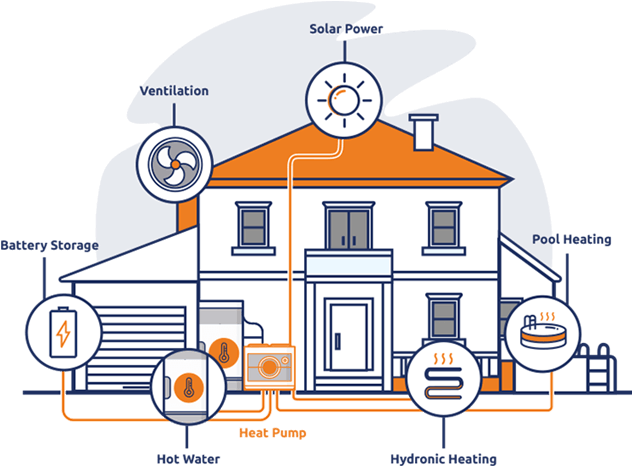
Solar Powered Heating & Cooling
Explore your solar powered heating and cooling options if you are planning an efficient electric home, renovation, going off gas or going off grid.
‘Whole of Home’ Design
Hydrosol can help you think through your needs, preferences, budget and develop a ‘Whole of Home’ design that works for you. This is important if your building project is in southern or inland Australia with cold winters.
This concept embraces high thermal performance with efficient heating, cooling, hot water and plug-in appliances, and solar power and batteries.
Achievable Outcomes
- Lower operating costs
- Beautiful indoor air quality and comfort
- Improved home capital value
- Lower Greenhouse emissions
Advice
Contact Hydrosol for advice at the design stage, when all options are available to you, including:
Resources
Hydrosol has assembled a rich resource library to assist your research into all-electric heating, cooling, ventilation, water heating and solar power. Also, feel free to contact us about your specific project.
About Us
Hydrosol’s business has evolved over many years to all-electric heating, ventilation and cooling (HVAC) design, including hot water and pool heating.
We have the experience, design capability and contracting experience that you need to create an excellent all-electric house.
Ask us for a complimentary referral for solar systems.
Contact Us
Contact us about your project. Explore your best options for a good ‘Whole of Home‘ design. Let us provide you with an indicative supply and install quotation.
When you are ready, we can make a referral to an experienced contractor capable of doing your project to a high standard.
Contact us also on Facebook.
All-electric Solar HVAC Design
There are many heating and cooling factors to consider in your house design to reduce power bills and improve comfort. Most importantly, an all-electric house with solar power must have good thermal performance.
This will deliver lower heating and cooling loads so that smaller heat pumps and/or air conditioners can be installed. Therefore, your capital costs and operating costs will be less.
Contact us for a tailored solution for your new build or renovation. We know from experience that every client has a unique set of heating and cooling design requirements.
Hydronic Heat Pumps
Hydronic heat pumps give you radiant heating, which is the most comfortable and efficient form of heating.
The advantage of hydronic systems is that heat is radiated from underfloor or floor level radiator panels because heat naturally rises. It is this that provides gentle even heat throughout your house where you feel it best.
Thermal Mass
Design internal thermal mass into your home if it is located in a southern Australian location.
Internal thermal mass acts like a thermal battery that absorbs day time heating and cooling energy powered by your solar system. This energy is then released inside your home after sundown. It reduces the diurnal temperature swings between day and night. It allows you to turn your heating and cooling systems down or off at night.
Heat Pump Cooling
Hydronic air-to-water heat pumps can cool as well in reverse cycle which is an important advantage over gas boilers. They cool by absorbing inside heat into the circulating water, transferring that outside.
Fan coil convectors can be added to your heat pump hydronic system for effective cooling via convection using chilled water. Reverse cycle air conditioners do the same thing except they use chilled refrigerant.
Both systems absorb moisture from inside your home and transfer that outside.
Air Conditioners
Air-to-air reverse cycle conditioners are similar to hydronic heat pumps except that they don’t use water for heat transfer. They transfer heat directly with your inside air using convection.
This is a simpler process and therefore reverse cycle air conditioners are less expensive. However, they cannot radiate heat.
Solar Power
Power your heating, cooling and hot water systems with solar power or green electricity. Play your part in helping to reduce global warming.
Consider the size and orientation of your solar array. In general, install as many solar panels as your roof, regulations, provider and budget will allow. You may even have sufficient power to charge an electric vehicle as well as your house.
